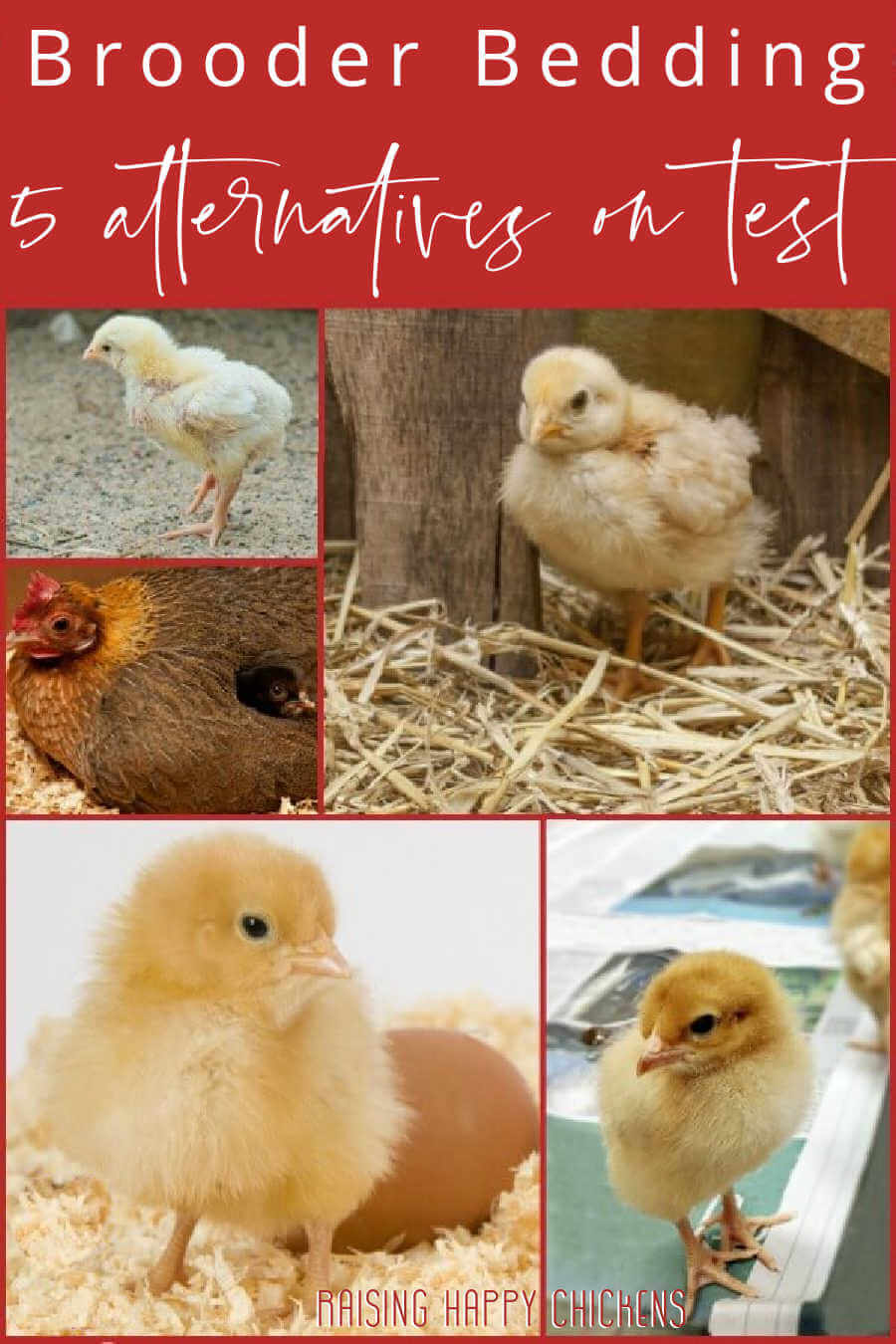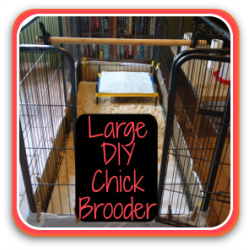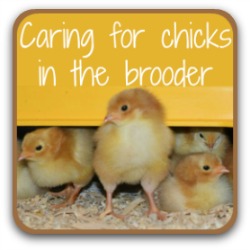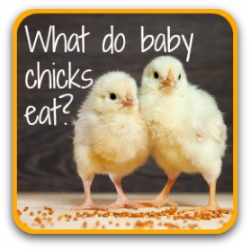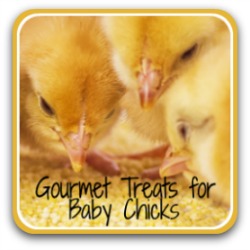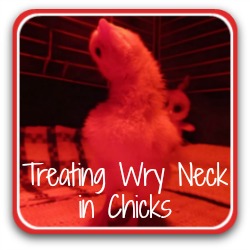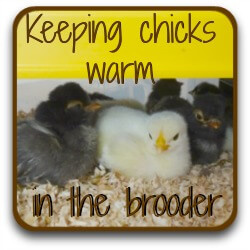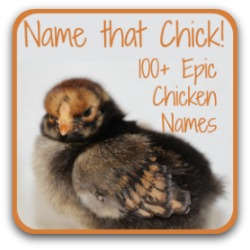- Home
- Chicks in the Brooder
- Brooder bedding
Bedding in the chick brooder: which is best, which is OK, which is definitely not?
So you're getting your brooder box ready for new chicks but you're not sure which kind of bedding is best?
It's understandable that you're confused - there's so much information out there, and a lot of it is conflicting.
My article is based both on personal experience in brooding chicks every year, and on information from peer-reviewed research about the pros and cons of different types of bedding.
We'll look at five different types of bedding, four of which I've used myself, and one I never would. You'll find the sources I've referred to listed here, at the bottom of this page.
The most important thing to remember here is to work out what works best for you. Each individual's situation is different: different climate, different humidity levels, differences in what's available to you locally.
There's only one type of bedding it's critical not to use. Apart from that, read about the differences and then make your own informed choice.
It really is that simple!
General advice.
Whichever bedding you decide to use, it's critically important never to let it get wet, or to leave droppings in it for long.
Particularly in first few days, this will mean cleaning it out very regularly – you'll discover very quickly that chicks are really major poop-machines!
That's just good husbandry - one of the responsibilities of having baby chicks.
Why is it important? Because bacteria like Coccidia - a potentially lethal disease - love conditions that are warm, wet and humid. It spreads quickly and it's potentially fatal to both chicks and adult chickens.
So, get into the habit of cleaning out your brooder bedding regularly.
Let's start our review by looking at the bedding every brooder should start with.
If you purchase a product through links on this page, I may receive a small commission at no extra cost to you. I only recommend products I have bought (or would buy) myself, and which I believe will genuinely benefit you. You can read my full disclosure policy here.
Shelf liner and paper towels.
Newly hatched chicks are pretty vulnerable. Just one look at their spindly little legs will tell you how easy it would be for them to be damaged.
Which is why the very first bedding material in any starter brooder should be non-slip. Slippery surfaces are the most common cause of spraddle leg - a condition where the chick essentially does the splits - and although it can be treated, it's always better to avoid it.
I use a plasticised shelf liner as my "must have" starter brooder liner. I also put it in the incubator at lock-down to make sure that when chicks hatch and start bumbling about, as chicks do, they don't slip in there, either.
It's inexpensive, it's available in nice bright colours if you like your brooder to look good, and it does a great job.
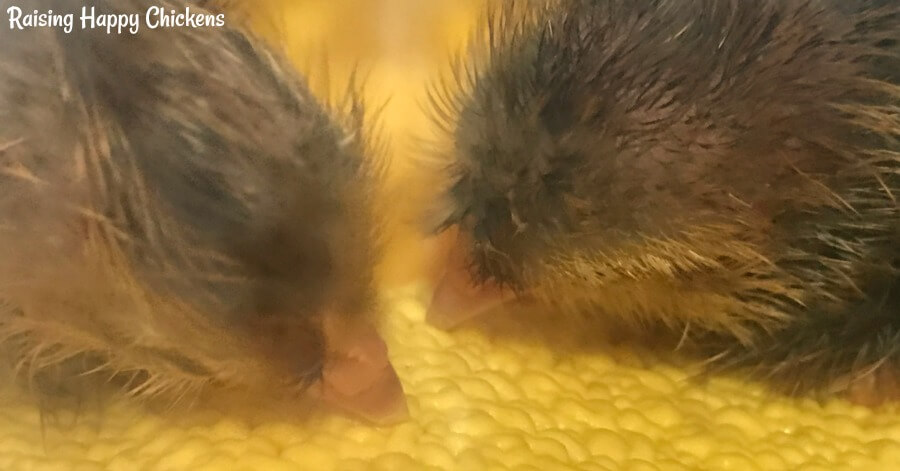 My baby chicks hatch onto a colourful plasticised shelf liner which prevents their feet from slipping.
My baby chicks hatch onto a colourful plasticised shelf liner which prevents their feet from slipping.Once in the brooder, I cover the shelf liner with some kitchen paper - again, an inexpensive option that works well.
Not only does it clean out easily (it's decomposes well in the compost, too) and prevent the chicks from slipping, it allows them to learn quickly what their feed looks, smells and tastes like.
The noise of sprinkling the feed onto the paper surface attracts their attention and, being the curious things chicks are, they will automatically peck at it to find out what it is. And then...
Yum - this tastes good! So they easily learn to distinguish food from bedding at a very early stage.
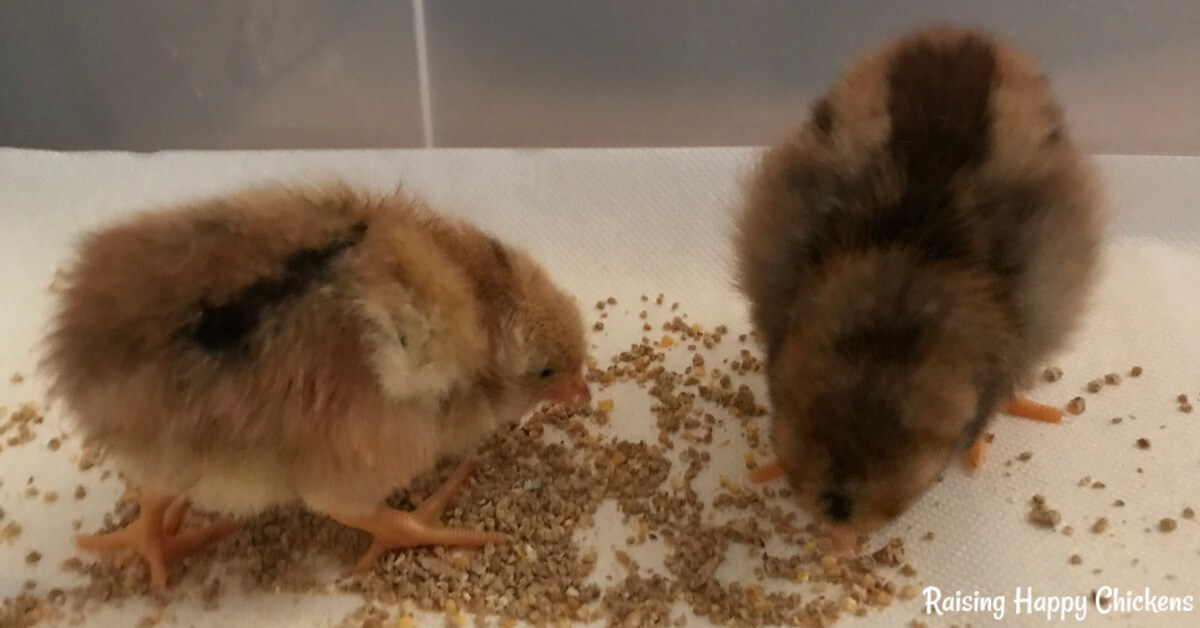 Two of my newly-hatched chicks learn what food tastes like.
Two of my newly-hatched chicks learn what food tastes like.Other bedding that can work well on top of a non-slip liner are puppy pads – although they're an expensive way of doing it – and old towels, although they're not as easy to keep clean.
That's why, for the chicks' first few days in the brooder, my vote goes to shelf liner and kitchen paper every time!
When should the bedding change from kitchen paper?
I normally keep the shelf liner and kitchen paper in the bedding for around four days. That gives the chicks a good chance to understand how food looks and tastes before putting in their more permanent bedding.
The danger with using bedding straight away, or taking out the paper towels too soon, is that the chicks mistake bedding for food and eat it. And that can cause serious problems with their not-very-well-developed digestive systems.
Once your chicks are ready to move onto the next stage of brooder bedding, you have a choice to make: pine shavings, sand or straw.
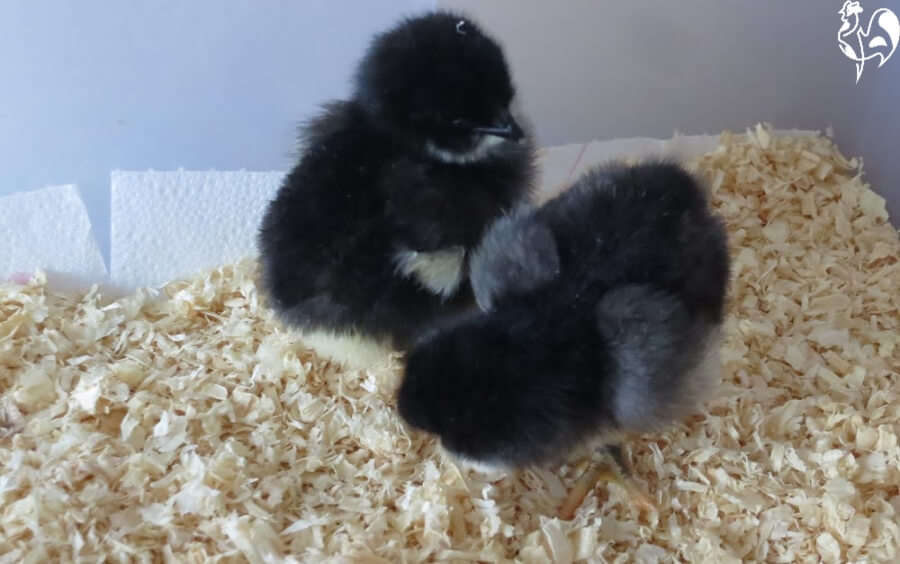 Two of my new chicks explore new shavings bedding in their first stage brooder.
Two of my new chicks explore new shavings bedding in their first stage brooder.Next stage brooder bedding: pine shavings.
Pros.
- This is the bedding I've used for many years in my brooder.
- It's easy to find at your local feed store, inexpensive, easy to clean out and composts down well to provide excellent organic materials to add to your flower bed or veggie patch.
- And the chicks love to scratch about in it.
Cons - and how to deal with them effectively.
- Make sure you buy untreated shavings. Some brands use aromatic oils to make it smell more pleasant, but they're not safe - they can affect the respiratory tract. And actually, the smell of natural wood is nicer - and much better for your chickens' health.
- Don't buy cedar shavings. The oil is harmful to both chicks and adult chickens. Invest in a good quality softwood shaving. Your local feed store will stock it inexpensively, or buy online at this link.
- There's documented evidence (see Sources) that wood-based bedding contains relatively high counts of aerobic bacteria. It's critical that, as with any bedding, it's kept clean and changed regularly.
- Wood isn't great at absorbing moisture and, as we've already seen, wet conditions means bacteria are more likely to multiply. Again, the answer is good husbandry: clean your bedding out regularly.
- Finally, chicks tend to get shavings everywhere. They kick them into their water, into their food, over the floor...
- The answer is to make sure you regularly clean out feeders and waterers - or use a watering system that hangs. Much easier for you, much more pleasant for your chicks.
- Unfortunately, the system I've used for years (below) is no longer available, but I discuss another, here.
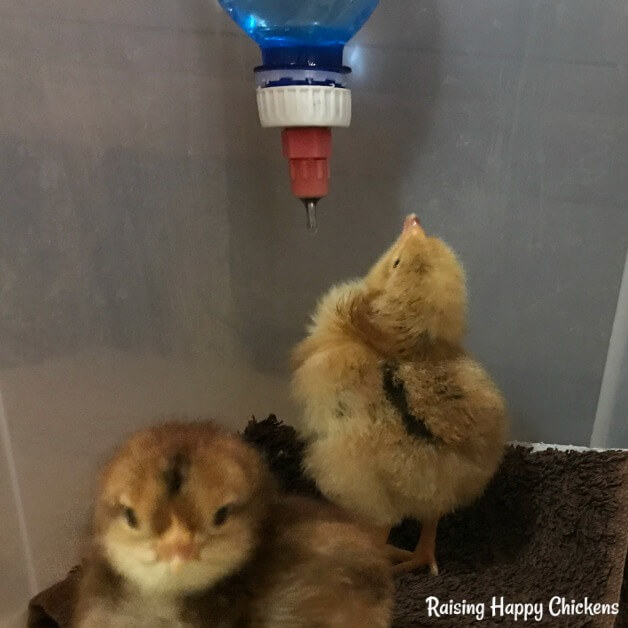 The chick brooder bottle cap was a great solution to keep your chicks' water clean.
The chick brooder bottle cap was a great solution to keep your chicks' water clean.Next stage brooder bedding: sand.
I have to admit that I was definitely a pine shavings kind of girl until I discovered sand in the brooder. But sand, like the other beddings, has its pros and cons.
Sand in the brooder: pros.
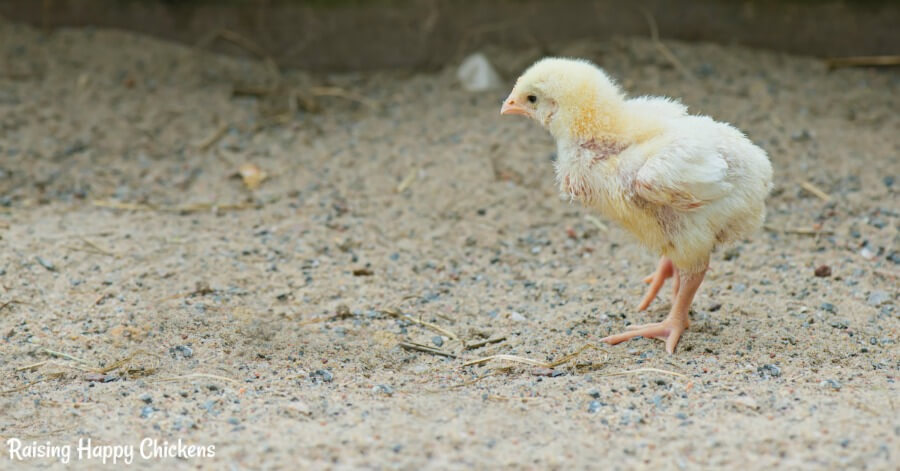
- All these pros are based on you buying the right kind of sand. Play sand, or very finely particled sand, won't do. It's too fine and likely both to provoke respiratory problems in young chicks and potentially to become impacted in the digestive tract.
- The only type of sand that's safe for both chicks and adult chickens is construction grade sand, also sometimes called river sand. It's heavier and doesn't give off as much dust.
- Research has shown(3) that without question, chicks raised on sand have a far lower chance of bacterial disease. Sand doesn't retain wet poop in the same way as other bedding materials - it dries and dessicates it. Bacteria therefore has a far lower chance of multiplying; counts of E.coli in particular were found to be lower in sand bedding.
- Additionally, chicks in a sand-based brooder have fewer problems with their feet. The sand acts as a kind of natural emery paper and keeps feet and nails healthy.
- Even very young chicks will want to dust bathe, particularly if you're hatching when the weather's hot. Sand is the ideal medium for them - as you'll see from this short video of some of my 5 day old chicks at "Brooder Beach"!
Sand in the brooder: problems, and how to deal with them.
- Sand can't be composted. Put it on the compost heap and you'll still find it there years later. It does, though, make a great addition to clay soil which is what we do with ours. Add to your veggie patch and the sand will ensure better drainage while the poop it contains adds much needed nitrogen. Perfect!
- Wet sand can take days to dry out, which is clearly a problem for chicks. Make sure the sand you buy is well and truly dry before adding it to your brooder.
- Sand does compact easily and forms a very hard surface. How to avoid? Simple - clean it out each day using a kitty-lit scooper and use the scooper to loosen any compacted sand.
- Sand under a heat lamp can become very hot - think of the beach on a sunny day. The answer? Use a radiant heat source such as Brinsea's EcoGlow. See my review of Brinsea's small and larger brooder lamps.
Next stage brooder bedding: straw.
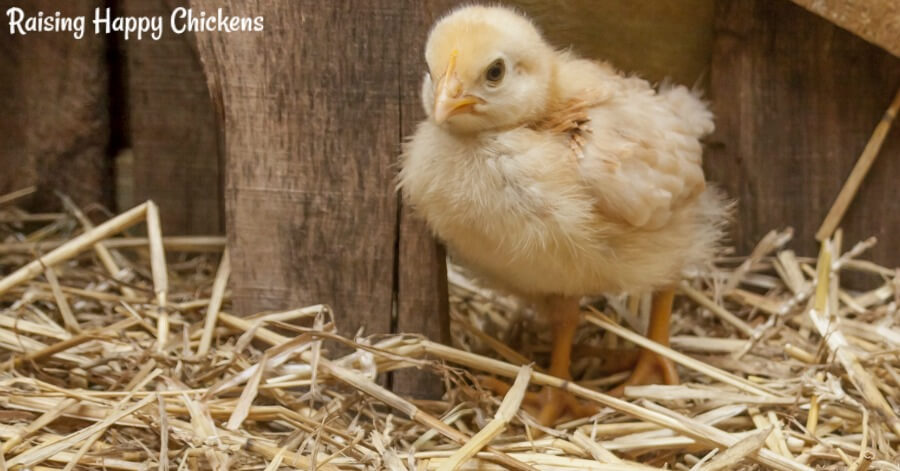
Straw and hay: both inexpensive, both natural, (as long as you don't buy a chemically treated product), both compost down very well.
I use straw in my chicken coop in the winter for added protection from our extreme winters (yes, Italy has extreme winters!), but I don't use it in my brooder.
Why?
In a large area like a coop, it's easy to follow the deep litter method, making sure the chickens turn the straw (or doing it yourself!) regularly so that the poop composts naturally. In a brooder, though - a much smaller area - that doesn't work as well.
It's just not absorbent enough. The poop collects, the straw doesn't absorb it, it lies around and potentially becomes infected. It can also become mouldy very quickly. Spores get into baby chicks' lungs and cause respiratory disease which they won't be able to shake.
Bad for the chicks, unpleasant to clean out.
Of course, if it's the only bedding you can find and you're prepared to keep well on top of the cleaning, then by all means go ahead and use it.
What not to use, ever: newspaper.
This is the one bedding which I will advise never, ever to use - newspaper. A lot of people do use it - it's cheap, and easy to come by.
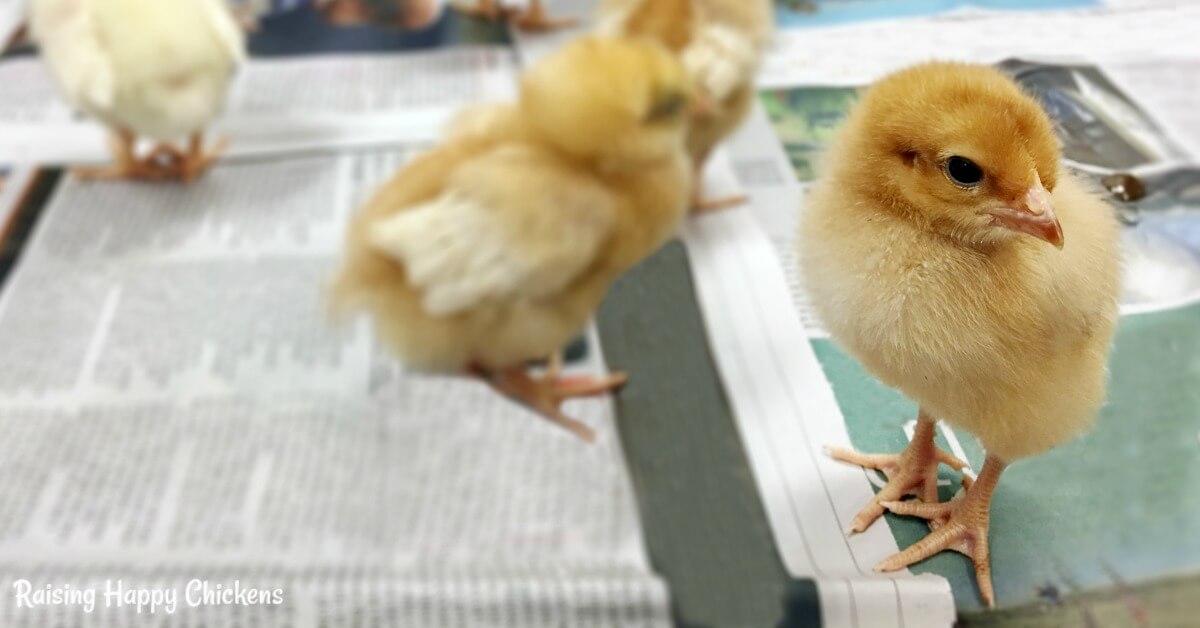
Why wouldn't I use it?
Two words: spraddle leg. Or dislocated leg. Take your pick.
To a newly-hatched chick, newspaper is slippy. Very slippy. And chicks slipping is never a good thing. It can lead to spraddle leg, when chicks essentially do the splits, and / or to a dislocated leg.
Although spraddle leg can be put right, it's painful for the chick and painful for you, as the chick's surrogate mother hen, to watch.
And dislocated legs in a young chick are impossible to put right.
Is it inevitable that they will slip? No. but it's a risk. Why take a risk with your lovely new chicks?
So, on this occasion do please take my advice - use anything but newspaper.
Looking for other information about raising happy chicks? Here's some articles that will interest you.
Sources.
A lot of "facts" you'll find on the internet are often people's individual views, based on inaccurate information repeated from poor quality sources.
The information I provide in this article and others is based not just on my own experience, but on evidenced facts from scientific, peer-reviewed research and books from highly respected and experienced poultry keepers such as Gail Damerow.
Some of the trusted sources I have used in this article are these.
1. Burke, Pescatore et al: "Newspaper as litter material". Pub Journal of Poultry Science, 1993.
2. S. F. Bilgili et al: "Sand as litter for rearing broiler chickens". Pub. Journal of Applied Poultry Science, 1999.
3. B.D. Bowers et al: "Sand litter temperatures during brooding". Pub. Oxford University Press, 2003.
4. V. A. Toroc et al: "Influence of different litter materials on cecal microbiota colonization in broiler chickens. Pub. Oxford University Press - Poultry Science, 2009.
- Home
- Chicks in the Brooder
- Brooder bedding
